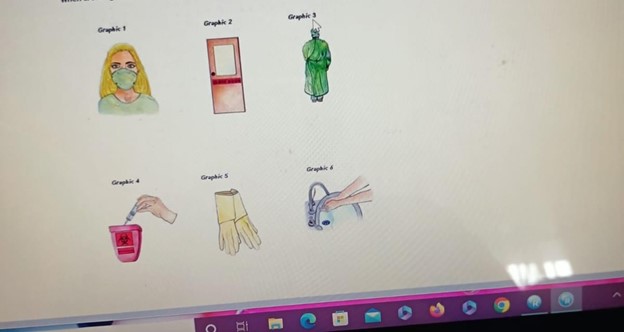A nurse is caring for a client who requires isolation for active pulmonary tuberculosis. Which of the following precautions should the nurse include when creating a sign to post outside of the client's room? (Select all that apply.)

please wear a mask
please wear a gown
dispose sharps here
please wear gloves
please wash your hands
radiation inside
Correct Answer : A,B,D,E
A. Wearing a mask helps protect against the transmission of airborne particles, which is important for preventing the spread of tuberculosis.
B. Wearing a gown can provide an additional barrier to prevent the transmission of infectious material.
C. Disposing sharps here is not directly related to tuberculosis precautions. This statement is more relevant for a sharps disposal container.
D. Wearing gloves is important to prevent direct contact with potentially contaminated surfaces.
E. Hand hygiene is crucial for infection control and should be emphasized for anyone entering or exiting the room of a client in isolation.
F. "Radiation inside" is not applicable to the isolation precautions for tuberculosis. This statement is unrelated to tuberculosis precautions and may cause confusion.
Nursing Test Bank
Naxlex Comprehensive Predictor Exams
Related Questions
Correct Answer is ["A","B","C"]
Explanation
A. Measurement of residual urine after urination is an indication of urinary catheterization because it can help diagnose conditions such as neurogenic bladder, bladder outlet obstruction, or urinary retention.
B. An open perineal wound is an indication for urinary catheterization because it can prevent contamination of the wound by urine and facilitate wound healing.
C. Relief of urinary retention is an indication of urinary catheterization because it can prevent complications such as bladder distension, infection, or renal damage.
D. Convenience for the nursing staff or the client's family is not an indication of urinary catheterization because it can increase the risk of catheter-associated urinary tract infection (CAUTI), trauma, or encrustation.
E. routine acquisition of a urine specimen is not an indication for urinary catheterization because it can be obtained by other methods such as clean catch, midstream, or suprapubic aspiration.
Correct Answer is C
Explanation
A. Autonomy vs. shame and doubt focuses on developing a sense of independence and autonomy in early childhood (around 1-3 years old). It does not directly involve acceptance of death.
B. Identity vs. role diffusion pertains to adolescence (around 12-18 years old) and involves the development of a sense of self and one's role in society. It does not specifically address the acceptance of death.
C. Integrity vs. despair is the stage that occurs in late adulthood (65 years and older), where individuals reflect on their lives. Acceptance of death is a significant aspect of achieving a sense of integrity during this stage.
D. Generativity vs. stagnation occurs in adulthood (around 40-65 years old) and involves concerns about contributing to the next generation and leaving a legacy. While mortality may be a consideration, it is not the primary task of this stage.
Whether you are a student looking to ace your exams or a practicing nurse seeking to enhance your expertise , our nursing education contents will empower you with the confidence and competence to make a difference in the lives of patients and become a respected leader in the healthcare field.
Visit Naxlex, invest in your future and unlock endless possibilities with our unparalleled nursing education contents today
Report Wrong Answer on the Current Question
Do you disagree with the answer? If yes, what is your expected answer? Explain.
Kindly be descriptive with the issue you are facing.
